City break Paris - the centre of France | H-Hotels.com
Even if it is not located at the geographical centre, Paris is at the heart of France. It is the country's political, cultural, spiritual and economic centre. Visit this unique metropolis on a city break and discover Paris in all its diversity! The Eiffel Tower, the Louvre Museum, or a trip on the Seine with the famous "Bateaux mouche" are just some of the highlights the city has to offer. If you open your eyes, you can discover much more:
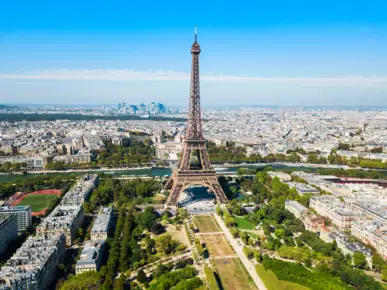
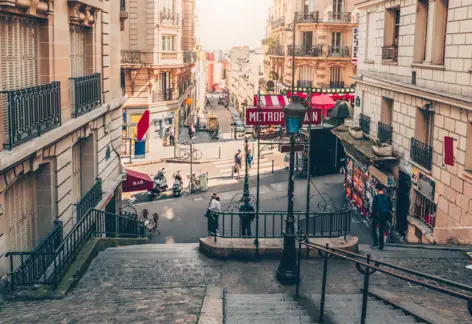
In the winding streets of the Montmartre district, you will find the old Paris of artists and bohemians. As the "city of love", Paris has a whole range of romantic squares and parks to offer couples in love. Fashion fans, on the other hand, can admire the latest creations of Parisian haute couture while window-shopping in the boutiques on Rue de Rivoli or Rue Saint Honoré.
The catacombs deep beneath the city are fascinating and a little creepy. Another insider tip is to visit the observation terrace of the Galeries Lafayette department store: you can find more tips and suggestions here in our travel guide. Plan your city break to Paris a little in advance so that you can accommodate everything that is important to you. Look forward to visiting one of the most beautiful cities in Europe and book your hotel accommodation for your stay. We look forward to welcoming you!
Discover Paris – book hotels in Vienna now at unbeatable prices!
Find your top hotel in Paris – at guaranteed best prices!
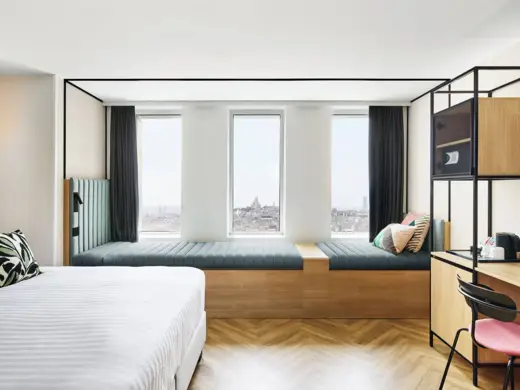
The first Hotel of the H-Hotels Group in France opened in July 2024. One of the most spectacular hotels in Paris, with 697 rooms on 40 floors and the highest swimming pool in the country, it is being built in the 140-meter-high Tour Pleyel in Saint-Denis. From the hotel, located right next to the Stade de France and the Olympic Village of the 2024 Summer Games, the center of Paris is just a short metro ride away.
City break Paris: what are the must-see attractions?
World-famous sights, romantic nooks, splendour and mystery: Paris has a long history, which is symbolised by monuments from past centuries as well as modern highlights. Some of them are simply unmissable! The Eiffel Tower, Montmartre and the Louvre also belong in this category - but more on these later.
The Ile de la Cité
The Ile de la Cité, an island in the Seine, is the origin of Paris - the Roman Lutetia. Its most famous building is the Gothic Cathedral of Notre-Dame, which can currently only be seen from the outside due to the fire of April 2019. The Sainte-Chapelle palace chapel is also Gothic. It is famous for its stained glass windows. Another place worth visiting is the Conciergerie, the former royal palace that contains the prison where Queen Marie Antoinette was imprisoned during the Revolution. Discover the Ile de la Cité and its buildings on a boat trip with the "Bateaux mouches".
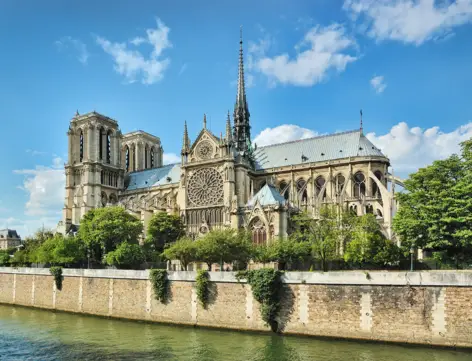
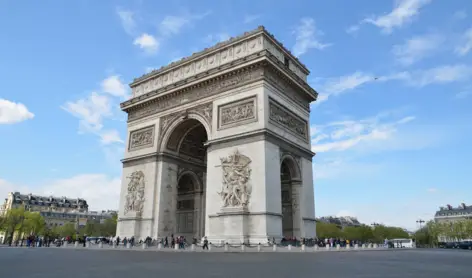
The Arc de Triomphe
The Arc de Triomphe, the triumphal arch built by Emperor Napoleon I to mark his victory at Austerlitz in 1806, is a mighty structure. It is 50 metres high and 45 metres wide. It stands at the centre of Place Charles de Gaulle, from which twelve large avenues radiate in a star shape. The Arc de Triomphe is at once a landmark, a place for state ceremonies, a memorial to those who fell in World War I, and the apex of parades and processions along the Champs-Elysées. From the observation deck, you can enjoy a direct view along this magnificent boulevard all the way to the Louvre.
Hôtel and Dôme des Invalides
The Hôtel des Invalides is a home for war-disabled soldiers built by order of King Louis XIV around 1670. Today, the monumental complex houses several museums, the most important of which is the Musée de l'Armée military museum. Another part of the complex is the Dôme des Invalides, a Neoclassical Baroque-style church that was converted into a burial place for Napoleon I in 1840. His sarcophagus, containing five nested coffins, stands in the open crypt directly under the enormous golden dome.
The Jardin du Luxembourg
The Jardin du Luxembourg is an oasis in the Parisian metropolis. Created as a royal palace park around 1611 by Maria de Medici, it is now a popular meeting place. There is a fountain with model boats, greenhouses, a rose garden, a bandstand, a café, a playground and countless chairs that you can position yourself. Today, the French Senate has its seat in the baroque Palais du Luxembourg. The Orangerie houses the Musée du Luxembourg art museum, the oldest public museum in France.
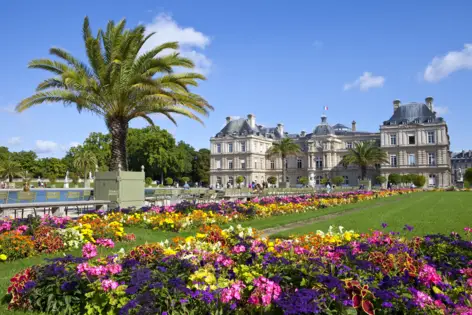
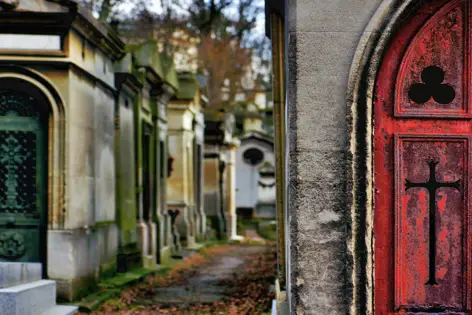
The Père-Lachaise Cemetery
The Père-Lachaise cemetery was created at the beginning of the 19th century when the city had to buy new cemetery land. It was the first cemetery in the world to be laid out as a park. The first burial - that of a five-year-old daughter of a municipal servant - took place in 1804. Since then, Père-Lachaise has become the final resting place of countless celebrities from the worlds of art, music, film, and science. Wander along the winding paths and follow in the footsteps of Balzac, Molière and LaFontaine, of David, Ingres and Delacroix, of Chopin and Rossini, of Saint-Exupéry and Oscar Wilde, of Sarah Bernhardt, Edith Piaf and, last but not least, of Jim Morrison, the singer of the Doors.
The Catacombs of Paris
The catacombs of Paris are a system of tunnels around 300 kilometres in length. They are located at depths of 5 to 35 metres beneath the city. The tunnels were created over centuries by mining building materials for the growing city of Paris. When the quarries were closed due to the risk of the houses above collapsing, they found use as an ossuary. This was a practical solution, as the overcrowded parish cemeteries began to close for reasons of hygiene from the end of the 18th century. In a very short time, the bones of more than 6 million people were brought into the tunnels. In 1809, this largest necropolis in the world was opened as a museum. A section of tunnel roughly two kilometres in length (entrance at Place Denfert-Rochereau), with bones and skulls (some arranged decoratively) piled up to the ceiling, creates a fascinating sight.
The Château de Versailles
Outside the gates of Paris, Louis XIV had a small hunting lodge converted into a palace worthy of a "Sun King" from 1668 onwards. The Castle of Versailles and its park are now a World Heritage Site and among the most important sights in France. It takes at least a day trip to see the magnificent halls and museums. The highlight is the 75-metre-long Hall of Mirrors, whose 357 mirrors reflect the view of the park. The Château Park extends over 715 hectares and includes ornate gardens, playful fountains, baroque pavilions as well as the Orangerie, the Grand Trianon and Petit Trianon pleasure palaces and the "Hameau de la Reine", Marie-Antoinette's own garden including an idealised village.
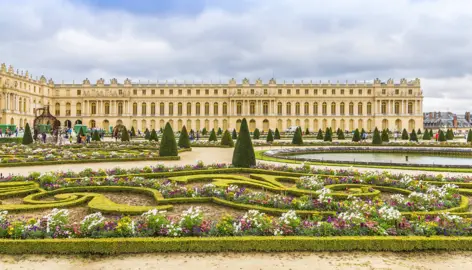

Disneyland Paris
Since 1992, Disneyland Paris has been welcoming fans young and old with fast-paced rides and many attractions. At the centre of the leisure complex are the two theme parks Disneyland Park and Walt Disney Studios Park. At Disneyland Park, the Disney classics come to life, as does the Star Wars saga. The themed areas include the galactic Discoveryland, the fairytale Fantasyland, the exciting Adventureland, the wild west Frontierland and Main Street USA. The Walt Disney Studios Park is all about Disney, Pixar and Marvel. In the Production Courtyard and Front Lot, you can feel like you're on set in Hollywood.
Where can you enjoy the best views of Paris?
There is only one answer to this question: from the Eiffel Tower. Built for the 1889 World's Fair, the 324-metre-high iron tower is the city's most famous landmark and tallest structure. The view from the three viewing floors is unique. If you don't mind the effort, you can take the stairs up to the second floor: this saves money and a lot of waiting time. The Champ de Mars stretches out at the foot of the Eiffel Tower. The grass and park are ideal for a picnic with a view of the tower, especially when it is illuminated in the evening!
The tallest building in Paris is the Tour Montparnasse near the station of the same name. It might not be as romantic, but one of the fastest lifts in Europe awaits you here: it takes you to the 56th floor in 38 seconds. The panoramic view from the viewing terrace at a height of 210 metres is fantastic. And it offers another advantage: you can see the Eiffel Tower better than when you are standing on it.
The Arc de Triomph and the Sacré-Coeur church, located on the hill of Montmartre, are less high and impressive, but still offer beautiful views of Paris. If you are planning a shopping tour in the Galeries Lafayette department store, we recommend a visit to the roof terrace on the 8th floor. You can get up there by lift or escalator: access is free and the view is great.
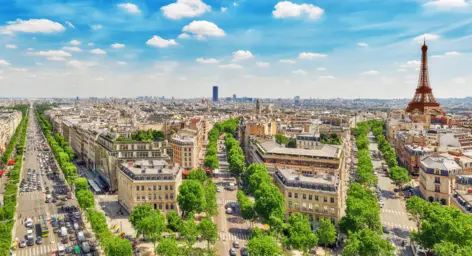
The most wonderful museums in Paris

In terms of importance, two of Paris's museums stand out above all the rest: the Louvre and the Musée d'Orsay. The Louvre, the former royal residence on the Seine, is the largest and most visited art museum in the world. Around 35,000 works are exhibited across a space of more than 70,000 square metres. In fact, the collection comprises more than 350,000 works from French and international art history, dating from antiquity to the present day. Plan plenty of time to discover all the other treasures alongside the Mona Lisa and the Venus de Milo. The Musée d'Orsay is smaller, but no less spectacular. Housed in a former railway station, it houses a unique collection of paintings, sculptures, handicrafts, photographs, architectural models and furniture. The works focus on a period of roughly 65 years between the revolution of 1848 and the beginning of the First World War. Among the most famous artists on display are Van Gogh, Manet, Liebermann, Cézanne, Monet, Rodin, Degas and many more.
Paris's art museums are also first-class in other respects. The Musée National Rodin, for example, displays the masterpieces of the sculptor Auguste Rodin and his mistress Camille Claudel as well as its own art collection. The Musée Picasso presents paintings and sculptures by Pablo Picasso, covering his various creative periods. It also houses his former private collection with works by Braque, Cézanne, Matisse, Miró and others. Other important locations include the Orangerie in the Tuileries Garden, whose rounded walls have provided a home for Monet's huge water lily paintings, and the Centre Pompidou with the Musée National d'Art Moderne, Europe's largest museum of 20th century art. Modernity is also at the heart of the Fondation Louis Vuitton, whose spectacular building was designed by Frank Gehry and houses eleven galleries containing modern art, and the Bourse de Commerce, where the Pinault Collection opened in 2021 with more than 10,000 contemporary works by 400 artists.
For history buffs, the Musée Carnavalet is certainly worth a visit during a city break in Paris. With thousands of artefacts, pictures and photographs, it tells the story of Paris, from Roman times through the Middle Ages and the French Revolution to the present day. Admission is free of charge. A wonderful impression of the world of the Middle Ages is evoked by the exhibits and works of art in the Musée de Cluny - le monde médiéval. Art, jewellery, wall hangings, crockery, carvings, and enamel work from several centuries are exhibited here.

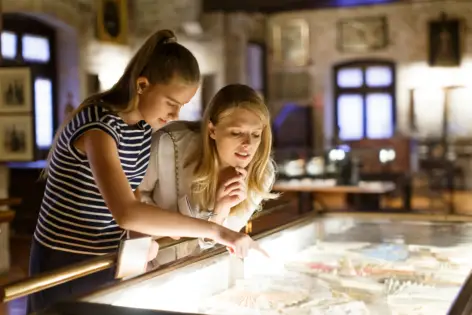
Planes in the nave and the Foucault's original pendulum? The history of science and technology is the subject of the Musée des Arts et Métiers, which uses the church of the former abbey of St-Martin-des-Champs as an exhibition hall. It is one of the oldest technology museums in the world and covers topics such as mechanics, communication, transport and scientific instruments. The Muséum national d'histoire naturelle, the natural history museum, explores nature and science. Founded in 1793, it now has the third largest collection in the world. Its subject areas are zoology, botany, geology and palaeontology. The museum also includes the scientifically run zoo, the Ménagerie in the Jardin des Plantes, which was also founded in 1793. For those interested in science and technology, a visit to the Cité des Sciences et de l'Industrie is a must. Here, the Explora presents impressive works from the recent history of technology. Its departments of mathematics, optics, acoustics, water and the sea, biology and biotechnology, energy, transport, mineralogy and volcanology, astronomy and space travel are each as big as a museum. The most popular exhibits include, for example, the TGV, a driverless VAL of the Métro, the flight simulator of an Airbus cockpit, the third stage of the European Ariane 5 rocket, and the deep-sea research submarine Nautilus.
Where can you go shopping in Paris?
Paris is also called "the city of fashion". So a shopping tour is virtually a must during a trip to the city. The most famous shopping street in Paris is without doubt the Avenue des Champs-Elysées, made legendary by films and songs. The boulevard leading from Place de la Concorde to the Arc de Triomphe is lined with countless shops. From Zara to Foot Locker, Adidas to Boss, Bulgari to Louis Vuitton, Rolex to Chanel, everything can be found here.
The area around Rue Saint-Honoré and Rue de Rivoli near the Tuileries is a chic shopping area in Paris. Accessories and fashions from famous and up-and-coming designers tempt you to window-shop or bring home an elegant souvenir from your city break. Yves Saint Laurent, Burberry, Maison Goyard, Vivienne Westwood, Gucci, Hermès, Chanel and Louis Vuitton are just some of the names represented here. Fine jewellery and watches can be found nearby at Place Vendôme: Patek Philippe, Rolex and Seiko await you here alongside Chopard, Cartier and Van Cleef & Arpels.
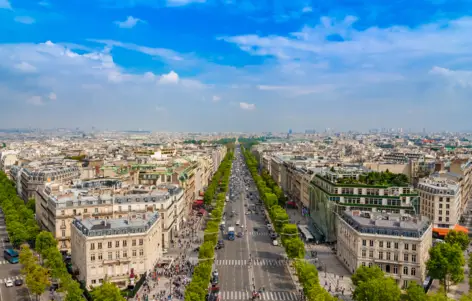

But there's another way to go in Paris: the "Puces de Saint-Ouen", the large flea markets at the Porte de Clignancourt, are perfect for an exciting shopping spree. Entire streets with over 3,000 stalls and second-hand shops have been creating a bustling 'bazaar' atmosphere here since 1885. Arranged into around 15 thematic areas, here you can find antiques for sale as well as jewellery and collectibles, and cheap flea market clothes.
Bookstalls along the Seine have been an institution since the French Revolution. There are about 900 bouquinistes who open their wooden stalls on the quay walls along the Seine from March to October, offering books, prints, comics, maps and much more. Most bouquiniste stalls can be found between the Quai du Louvre and the Pont Marie bridge on the right bank of the Seine and between the Quai Voltaire and the Quai de la Tournelle on the left bank.
Romantic Paris: Journey to the City of Love
Paris, the city of love: this nickname probably dates back to the 18th century - the time of artistic and literary Romanticism. This era was characterised by many artists and writers from Paris. Today, Paris has an entire museum dedicated to this chapter of its history: the "Musée de la vie romantique". However, the origin of the name is not entirely clear: perhaps it is simply the unique, romantic charm of the city to which it owes this epithet.

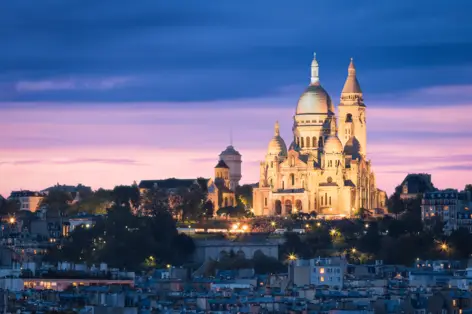
Paris feels particularly romantic - just as you'd imagine - in the district of Montmartre. Small cobbled streets, pretty cafés and shops as well as numerous galleries characterise the artists' quarter. Famous painters such as Van Gogh, Picasso, Monet and Toulouse-Lautrec once lived here, and to this day numerous studios, painters and caricaturists can be found around the Place du Tertre. Montmartre is a hill, and the white basilica Sacré-Coeur is perched on its summit. It's best to take the metro to Station Abesses - which is one of the stations with picturesque Art Nouveau exits - and explore the district on foot from here. The first must-see for lovers is in the small park just behind the metro station: "le Mur je t'aime" (the "I love you wall"). On the wall of the house you can read the magic words "I love you" in 250 languages. It is a work of art that is meant to stand for the union of torn humanity through love. It is a good idea to walk from here through the small streets to Square Louise Michel, a gently sloping park that stretches up to the Sacré-Coeur church. Go by foot or take the small cable car on the side. The view from the terrace above is beautiful.
Another must for all couples and romantics is a walk along the Seine. The quais have become a popular meeting place. Especially in the evening, people like to meet here - for a chat, a picnic, or a romantic liaison. In the glow of the setting sun, the sights from Notre-Dame to the Eiffel Tower shine with a light all of their own. Stroll from bridge to bridge, starting at the Pont Neuf, the oldest Seine bridge in Paris, then the popular pedestrian bridges of Pont des Arts and Passerelle Léopold-Sédar-Senghor. Conclude your stroll at the magnificent Pont Alexandre III.
You can also imbibe the romantic charm of Paris in its parks and gardens. The Parc des Buttes Chaumont is particularly picturesque. The hilly landscape park in the 19th arrondissement was artfully laid out in a former quarry in 1867 for the World's Fair. It enchants visitors with its bridges, ponds, grottos, caves, a waterfall and a small temple perched high on a rock: all this is waiting for you to discover - ideally with your significant other!
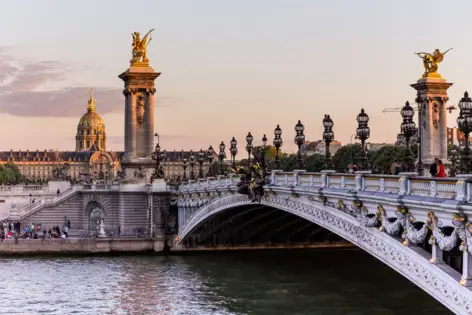
Parisian districts with flair

Paris consists of 20 so-called arrondissements, numbered in a spiral from the Ile de la Cité. Each of these districts has its own charm and unique features. A suggestion for your city trip to Paris: discover a different arrondissement every day. We would like to introduce some of them here:
Le Marais: in the 3rd and 4th arrondissements
The Marais stretches between the Centre Pompidou, the Place de la République and the Place de la Bastille, and belongs to the 3rd/4th arrondissement. In this very original quarter, magnificent city palaces stand next to narrow tenement houses. It is characterised by boutiques, galleries and junk shops as well as many bars. One of the most beautiful squares in the city is the elegant Place des Vosges, where Cardinal Richelieu and Victor Hugo lived. The Marais is the historical centre of Jewish life. Not only are there many kosher restaurants here, but it is also home to the Museum of Jewish Art and History and the Shoah Memorial. Sights include the Musée Picasso and the Musée Carnavalet.
In the Latin Quarter: the 5th arrondissement
The 5th arrondissement, the so-called Latin Quarter to the south of the Ile de la Cité, is home to the historic university. Here, you will find the Sorbonne, the oldest university in Paris, countless bookshops, and many popular student cafés. If you want to catch your breath after a stroll through the lively little streets, the Jardin des Plantes - the botanical educational garden - is the place to go. The Natural History Museum is also located here. Another sight worth seeing is the neoclassical Panthéon, the hall of fame and burial place of French personalities from politics, science and culture.
Saint-Germain-des-Prés: in the 6th arrondissement
The Saint-Germain-des-Prés district is characterised by elegant galleries, bookshops, boutiques and chic restaurants. The medieval church of Saint-Germain-des-Prés is one of the oldest in Paris. In the immediate vicinity, on Boulevard Saint-Germain, you will find the Café de Flore and the brasserie Les deux magots, made famous by guests such as Oscar Wilde, André Breton, Simone de Beauvoir, Jean-Paul Sartre, Ernest Hemingway, Pablo Picasso and Umberto Eco. The bouquinistes on the banks of the Seine are typical of Saint Germain. The most important sight is the Musée d'Orsay.


Opéra Garnier and Lafayette: the 9th arrondissement
The highlight and eponym of the 9th arrondissement is the Opéra Garnier, a magnificent building dating back to 1875. Until 1989, the opera house was the largest theatre building in the world and is the original setting for the story of "The Phantom of the Opera". Not far away, on Boulevard Haussmann, are the flagship shops of the two famous Parisian department stores: Galeries Lafayette and Printemps. How about an exclusive shopping trip with historical charm? Further towards Pigalle, restaurants, clubs and theatres such as the Casino de Paris, the Olympia concert hall and the Variété Folies Bergère characterise the 9th arrondissement.
On the Canal Saint-Martin: the 10th arrondissement
The Canal Saint-Martin crosses the 10th arrondissement and is a popular meeting place with its footbridges and artists' cafés. Its tree-lined banks and romantic charm are well known from films and literature. Restaurants with specialities from all over the world as well as bars and cafés await guests along the canal and in the surrounding area. The covered market of Marché Saint-Martin is also a paradise for foodies. Behind the district's imposing town hall on Rue du Château-d'Eau stands a tiny highlight: the smallest house in Paris. It is 1.10 m wide and 5 m high and consists of a shop and a room above.
City trip to Paris: Facts about the French metropolis
Paris is the capital of France and is located in the northern part of the country on the banks of the Seine. The city of Paris, i.e. the inner city area within the Boulevard Périphérique ring road, has a population of just over 2 million in an area of around 100 km². This makes the city very densely populated, with around 20,300 inhabitants per square kilometre. If you include the built-up area of the city outside the Boulevard Périphérique, Paris is one of the largest metropolises in Europe with 17,000 square kilometres and more than 12 million inhabitants.
Paris is home to the French government, UNESCO, the OECD and the ICC. The city forms the economic and cultural centre of centrally organised France. As the country's largest transport hub, Paris has six terminus stations and four airports. The banks of the Seine and the monuments there, from the Eiffel Tower to the Dôme des Invalides, the Tuileries and the Louvre to the Île de la Cité and the Île-Saint-Louis, are UNESCO World Heritage Sites, as are the Palace and Gardens of Versailles.

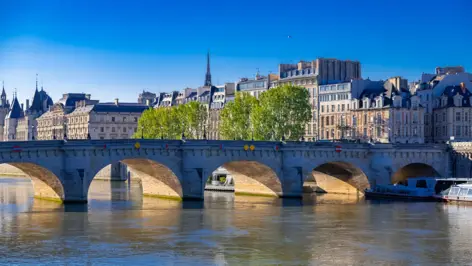
Paris's origins lie on the Île de la Cité: the Celtic settlement of Lutetia was developed into a city by the Romans and was a main residence of the Frankish Empire from the 6th century onwards. The 16th and 17th centuries under François I and the absolutist kings from Louis XIV onwards form a unique chapter in the city's history. Numerous magnificent baroque buildings and streets were built during this period. In 1789, Paris was the centre of the French Revolution, which changed the world far beyond the borders of France with its slogan " Liberté, Égalité, Fraternité". During the industrialisation of the 19th century, the population increased rapidly, suburbs were incorporated, and factories and railway stations were built. In 1846, Paris had 1 million inhabitants. Between 1855 and 1937, six world exhibitions with worldwide recognition were held in Paris.
Arriving in Paris
You can travel to Paris by train/long-distance bus, by car or by plane. Trains from Germany usually arrive at Gare du Nord or Gard de l'Est. Direct connections with the ICE or TGV are available from Frankfurt am Main or Cologne, for example. Long-distance bus connections to Paris exist from many German cities. Depending on the departure point, the journey takes between around 7 (Cologne), 11 (Munich) and 15 hours (Leipzig).
The flight time from Berlin or Munich to Paris is a little less than 2 hours. You will arrive either at Charles-de-Gaulle airport or Orly airport. Both are located about 15-20 kilometres outside the city and are connected via the RER suburban railway.
The main road routes take you either through Belgium via Brussels or Liège, or further south via Saarbrücken, Metz and Reims.
We recommend that you use the metro as much as possible during your stay in Paris, to ensure that you can get around quickly, beat the city's traffic, and avoid parking problems.



